

The Official Publication of the Bucks-Mont Astronomical Association, Inc
____________________________________________________________________________________________________________________________________
©2001 BMAA, Inc
Club Telescopes
Clinic for New Telescope Owners
- by Ed Radomski
Need help in setting up or using your new telescope, would you like to know how to use one of the club scopes or just how to get started in Astronomy? Then contact Ed Radomski, 215/822-8312 Ejrado@prodigy.net, to make arrangements to attend a beginner's clinic to be held at Ed's house in Chalfont. Ed will arrange the details of date and time with you. He is also looking for help from experienced members so we can have just one or two students/teacher. Hopefully we can have several sessions during the season to get new members up and running in their new hobby.
Ed is also the keeper of the five scopes that are available for use by members. Again, contact him to schedule your use of one of the following:
- an 80mm Equatorial Refractor with eyepieces.
- a 4 1/2" Edmond Equatorial Reflector on a pipe pier mount.
- a fork mounted 6" Dynamax with tripod and eyepieces.
- a fork mounted 8" Dynamax with tripod and eyepieces.
- a 4 1/2" Edmond Astroscan 2000 with eyepiece tabletop or tripod bracket.
This telescope is intended for use at public star watches.
* * * * * * *
- Long-time member Ed Radomski, BMAA Treasurer, also has a small observatory at his home. [ -ed]
_________________________________________________________________________________________________________________________________________________
2001 MEMBERSHIP DUES ARE DUE NOW!
* * * This is your last CONSTELLATION if your dues are not current * * *
__________________________________________________________________________________________________________
Astronomy 101 is an informal Q & A session before each General Meeting at 7:30p,
__________________________________________________________________________________________________________
The next BMAA General Meeting is scheduled for Wednesday, February 7 at 8:00p
___________________________________________________________________________________________________________________________________
BMAA MESSAGELINE - 215/579-9973
___________________________________________________________________________________________________________
The CONSTELLATION is the official publication of the Bucks-Mont Astronomical Association, Inc, a 501(c)3 non-profit organization incorporated in the Commonwealth of Pennsylvania and exists for the exchange of ideas, news, information and publicity among the BMAA membership, as well as the amateur astronomy community at large. The views expressed are not necessarily those of BMAA, but of the contributors and are edited to fit within the format and confines of the publication. Unsolicited articles relevant to astronomy are welcomed and may be submitted to the Editor.
Reprints of articles, or complete issues of the CONSTELLATION, are available by contacting the Editor at the address listed below, and portions may be reproduced without permission, provided explicit acknowledgement is made and a copy of that publication is sent to the Editor. The contents of this publication, and its format (published hard copy or electronic) are copyright ©2001 BMAA, Inc.
In an effort to transmit the CONSTELLATION electronically to the membership of BMAA, please provide a current e-dress to the Editor. Abbreviated issues are available on the web site, but complete editions will be e-mailed to members in good standing.
Submission deadline for articles is the 15th of the month prior to publication.
Bucks-Mont Astronomical Association, Inc
StarWatch Chairman: Ed Radomski - 215/822-8312, ejrado@prodigy.net
Information Line - 215/579-9973
__________________________________________________________________________________________________________
Forum
WHYY-FM SkyTour at North Penn High School
- Antoine Pharamond, BMAA VP, e-mailed this brief report following the SkyTour in Lansdale on January 31:
The SkyTour went darn near perfectly! The cloudy skies cleared, leaving us with a beautiful, warm, breezeless night. The seeing was pretty good too. I even had a guy ask me if there was a gap near the edge of Saturn's ring! There were 10 or 12 members and pretty close to 20 scopes total. The official estimate of public attendance was 800-900, although I would put it at closer to 500. That's a whole bunch of people any way you cut it! We wowed the crowd with Jupiter, Saturn, the crescent Moon and the Orion Nebula. I'm pretty sure we handed out all the flyers Ed Radomski brought.
- Antoine Pharamond
* * * * * * *
Beginning with the March 2001 edition (Vol XVI, No3) of the CONSTELLATION, this newsletter will be distributed electronically as much as possible. Currently, all members with internet access are able to download the publication in its entirety as a .pdf that will print out exactly as the hardcopy version. Therefore, printed newsletters will only be mailed to members without internet access or to those members that specifically request a hardcopy version. All members with an e-address will receive an e-mail notice each month when the new issue is posted on-line and available for download. Printed newsletters will always be available at the general meetings.
The CONSTELLATION has consistently been the largest expense for the club and reducing the printing and mailing costs will make a significant difference in the annual budget.
- Scott Petersen, editor
_________________________________________________________________________________________________________________________________________________
STAR TEST
- by John C Deitz
The star test is the final test reviewed in this series of articles. It is the oldest of tests, and is to this day commonly employed by amateur telescope builders in construction of telescopes (particularly compound systems). It is extraordinarily sensitive (to 1/20 wave even in the field) and readily shows a broad spectrum of aberrations.
Like other field tests, this one needs calm air. Just how much a star image jumps around is dependent upon the length of the column of air the light traverses. This distance can be reduced by use of an artificial star. More of this later - let's take a look at the technique as applied under the stars.
All that is necessary to begin exploring the method is a 10mm or shorter focal length eyepiece! The test centers around examination of the diffraction pattern of an OUT OF FOCUS star image. The pattern INSIDE focus is compared to the pattern OUTSIDE focus. This pattern is symmetric (close to focus) in a perfect system. That is, the pattern seen at a given distance inside focus should be the same as seen outside focus (at the same distance). Also, the pattern, at any location (inside or outside) should be ROUND. This idea of symmetry is central to the star test.
Unlike the other tests, this one is dependent upon the wave nature of light (physical optics). The other tests, the Ronchi and knife edge, are geometric and best viewed as considering light as a particle. The star test is extremely sensitive- to 1/50 wave or better under ideal conditions. Perform the test each night you use your telescope until you are comfortable with the method. As with observation of the planets, double stars, or any other discipline of astronomy, it takes practice. By all means pick up a copy of Suiter's Star Testing Astronomical Telescopes.
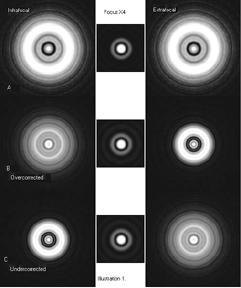
Illustration 1 shows the star test of a perfect 8" telescope. The first panel is inside focus, the middle panel is at focus, and the right panel is the same distance outside that the first panel is inside. The center image (at focus) is magnified relative to the other two. As we move either side of best focus the central disc (Airy spot) expands and more light is moved into the outer diffraction rings. At best focus, approximately 85% of the light is in the disc and first ring. Notice the strong symmetry each side of focus. The light does not "bunch-up" anywhere. Contrast this image with the second row (B). Here the light is "bunched-up" in the center for the right image (outside focus), or "spread-out" into the outer rings inside focus. This is an example of overcorrection - the mirror (if Newtonian) is "too deep" relative to ideal. In row "C" we see the reverse- the light is "bunched" into the center on the infrafocal (left) image. This mirror (or system, or refractor) is undercorrected- the mirror is "too flat" and not fully parabolized. These examples contain the image of the secondary, of 33% diameter. The secondary shadow makes the assessment of the star test a little easier when it comes to judging if light is added to the center or outer portion of the pattern.

The very edge of an objective, mirror or lens, is very difficult to control during manufacture. With a turned down edge, a common defect of reflectors, we see light added progressively into the outer rings on the extrafocal position (Illustration 2, right). This defect can be cured by placing a stop over the outer 1/8 to 1/4 inch of the mirror, and should be seriously considered as this defect is very detrimental.
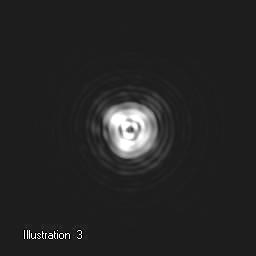
Roughness of the optical surface looks much like turbulence. Turbulence frozen, that is! It can be imagined as resulting from a generalized "wavy" surface, "dog biscuit" to the mirror maker (Illustration 3). Here there are multiple highs and lows on the objective, resulting in advancement and retreat of the wave front. In fact, there is no longer a wavefront as such. Roughness is easy to spot when the air is calm. Be sure the objective has had plenty of time to adjust to ambient temperature. The out-of-focus star image shows distortion of the rings and central disc. The appearance is similar inside and outside focus for pure roughness. This aberration is very detrimental and relatively common. Contrast is quickly lost in the presence of roughness, with resultant loss of detail of the planets.
Aberration of the wavefront resulting from layers of air within the tube produce asymmetric out-of-focus star images- one edge is seen to produce a spike or to flatten. The image slowly changes as air moves up the length of the tube. This is common seen in the Newtonian. Use a large stiff card to move air down the tube and see the pattern change. Adding a fan to the side of the tube just above the mirror will help mix the air. Some compound instruments are manufactured with fans to mix the air in the tube. Accessory fans for compound telescopes and refractors are available.
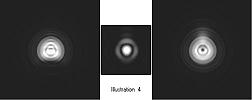
Illustration 4 shows a mild amount of tube disturbance inside and outside focus. Generally hot air hugs the top side of the tube. Baffles worsen the situation by forcing hot air into the light path- here the cure is building a fan into the tube. I have seen Newtonians conduct air from a warm driveway from the low open end and discharge it at the top. A plastic bag over the low end eliminates the problem, BUT may not allow good cooling of the mirror!
Coma and astigmatism are the primary off-axis aberrations visible in the star test. Coma and astigmatism are best seen with a low power eyepiece precisely because they are off axis aberrations. That is, the amount of aberration increases as one moves away from the center of field of view. Use a 25mm or longer focal length eyepiece to appreciate these aberrations.
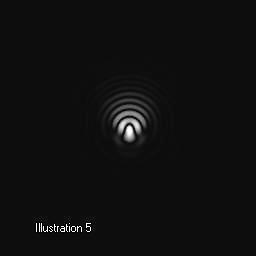
Coma (Illustration 5) turns off-axis star images into little comets that point toward the center of the field of view. Coma always points toward the center- inside focus, at focus, and outside focus. Contrast this with the oval shape seen with astigmatism, Illustration 6.
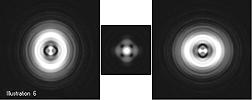
The orientation of the oval rotates by 90 deg when shifting the focus from inside to outside focus. Coma becomes very evident in Newtonians, particularly in short focal ratio instruments. Coma correctors can be employed to control this aberration to a great extant.
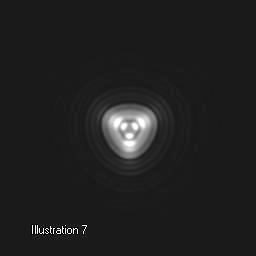
Telescope optics may be pinched by the mounting cell, or they may "flop" on the three point suspension. This will introduce a triangular shape to the out-of-focus star image (Illustration 7). This can be corrected, in the case of pinch, by reducing the pressure from mounting clips. The thin plate glass mirrors of some light buckets will be seen to flex over the three point mounting systems when in some positions.
Chromatic aberration is a result of refraction of light, and if seen in a reflector it is an aberration of the eyepiece. Chromatic aberration is best seen when observing the bright limb of the moon against the dark sky, or, for now, Venus is a very fine target. Image the moon or Venus inside and outside the best focus and look for fringes of color against the dark sky.
The position and brightness of the diffraction rings are dependent upon the wavelength being considered. In low light levels the eye is most sensitive to green light, and unless the source is bright most other colors are of little consideration. However, the use of a green filter during the star test will make the rings stand out a little better.
The star test can be carried out with an artificial star. Use of an artificial star offers several advantages in regards to control of brightness, use of filtration, lack of need of a drive etc., but above all it reduces the dependence upon a clear AND steady sky. The close proximity of an artificial star reduces the length of the turbulent path. The test object should be bright, tiny and at a reasonable distance. The larger telescope of short focal length requires the test star be located at a greater distance. For 6" and 8" telescopes from F/6 to F/8 the bright reflection of the sun at 100 feet away in a Christmas tree bulb is perfect. I use one of the parking lots at Tyler park at sunrise over a grass field. The same location works well using one headlamp of an automobile after sunset. The details are important, so check Star Testing Astronomical Telescopes by H R Suiter (Willmann-Bell) for the rest of the requirements.
What does all this do to telescope performance? Illustration 8 shows a double star with 0.58 arc sec. separation, with perfect optics. In illustration 9 things have been stacked against us. He we see the same separation BUT with 1/4 wave spherical aberration AND the stars separated by 2 magnitudes in brightness. Keep in mind that this demonstration is WITHOUT any turbulence thrown in!
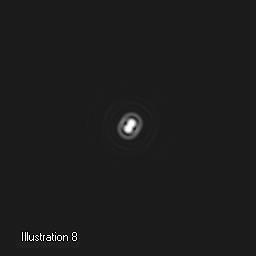

All of the images used in this article were generated by Aberratorv253 written by Cor Berrevoets. This program, available free of charge on the web, is an extraordinary learning experience. With it you can explore the image aberrations until your heart is content. It would take years of use of dozens of telescopes to see the effects of aberration, and combinations of aberrations, that can be observed in just a few hours use of this remarkable program. With this program you can select aperture, amount of obstruction, and set spherical aberration, coma, turbulence, etc. and then animate so that the changing diffraction pattern can be seen as you move to varied focus positions! Pairs of double stars can be used to demonstrate what happens at the eyepiece, or, and this is really neat, images of the planets can be modified to show varied images with assorted aberration "dialed in"! There is even a section (under development) for analysis of chromatic aberration. Point spread function, as well as modulation transfer and pupil function are calculated and displayed.
This has been a whirlwind tour of aberration. Download Aberrator, get out under the stars and do some star testing and things will become clearer. I addressed the major aberrations with out detailed discussion. In coming articles I will, in turn, discuss the various aberration and how they occur, what can be done about them, and how they look with the star test, Ronchi, and knife edge. In the meantime get and keep your telescope collimated (also the subject of a future article).
John C Deitz
* * * * * * *
- BMAA member John C Deitz provides this series of technical articles and can be reached at
johncdeitz@cs.com. [ -ed]_________________________________________________________________________________________________